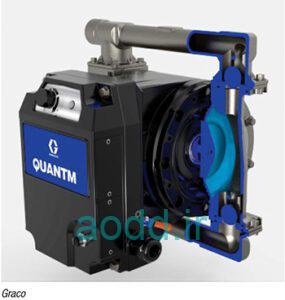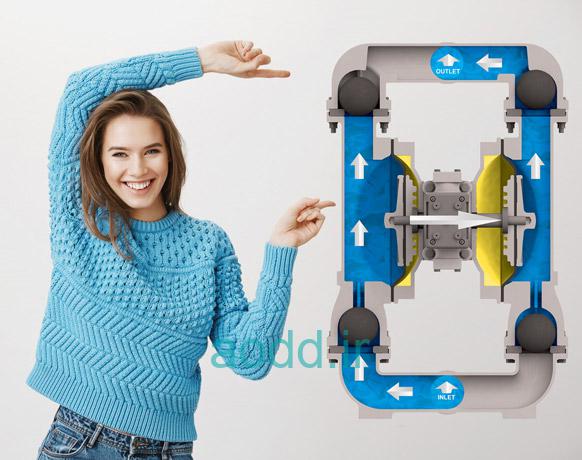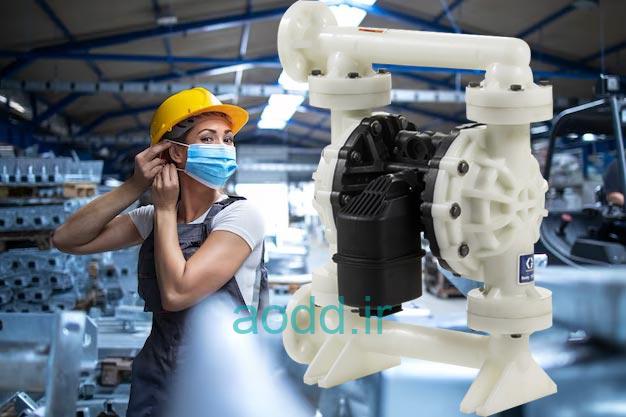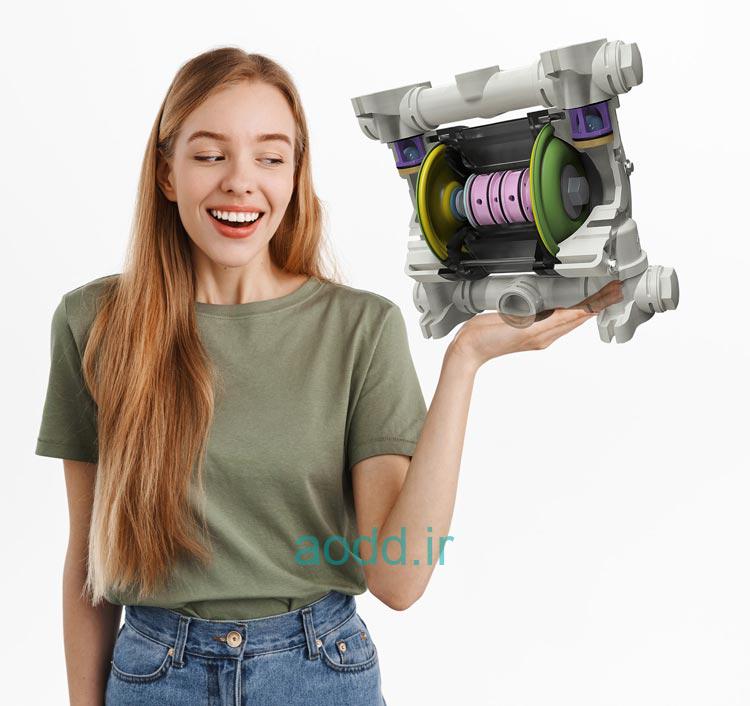pump What is an AODD ?
The air-driven double-diaphragm (AODD) pump is a class of positive displacement pumps driven by compressed gas. The gas engine actuates opposing diaphragms connected to a common connecting rod. There are check valves that control the flow from the intake manifold into the liquid chambers and then out to the exhaust manifold. Liquid chambers according to the movement of the diaphragm are filled and emptied . Figure 2 provides a cross-sectional view of the AODD pump and highlights the component nomenclature
Some of the advantages of AODD pumps are:
Solids passage, self-priming, low liquid shear, efficient over wide viscosity range, no mechanical sealing or packing, flow and pressure regulated by air inlet pressure and no electric motor.
Some of the limitations of AODD pumps are: limited available air pressure, inherent pressure pulsation, air consumption may be less than a motor-driven system, and lean materials may be problematic.
For more information on AODD pumps see ANSI/HI 10.1-10.5 Ventilated Pumps for Nomenclature, Definitions, Applications and Performance at pumps.org.

What is a diaphragm pump?
Diaphragm pumps are a type of positive displacement pumps with a pneumatic or air working mechanism that are used to transfer a wide range of fluids in different flow ranges. These pumps use the reciprocating function of the diaphragm to pump fluid. Therefore, they are categorized in the positive displacement pump branch. These pumps have the ability to transfer any type of fluid such as water, chemicals, oil, slurry, etc. Air diaphragm pumps without water seal are self-priming and have a non-uniform output flow, and have the ability to adjust pressure and flow in their working range.
Diaphragm pump performance:
The most common type of these pumps is the two-channel diaphragm pump , which is composed of two chambers and two flexible diaphragms that have mutual reciprocation. Diaphragms are connected with a shaft and work as a fluid movement agent.

The air compressed by the compressor is directed to the back of the diaphragm number one by the air distribution valve and moves it away from the central part, this reduces the volume of the chamber one and increases the fluid pressure, resulting in its exit from the valve one. It is turned and pumped. At the same time, the air behind diaphragm number two is pushed forward, this action increases the volume of chamber two and fluid suction into the pump. When the movement of the number one diaphragm is finished, the air movement from behind the number one diaphragm to the back of the number two diaphragm is changed by the air distribution valve.
The compressed air moves diaphragm number two away from the central part and diaphragm number one closer to the central part. In part two, the valve moves one-way and the fluid comes out, while in part one this happens. Upon completion of this operation, the air distribution valve again transfers the air to the back of diaphragm number one and the cycle is complete. This action is very similar to the human breathing mechanism.
Schematic of diaphragm pump operation:
1. Fluid draining 2. Ball valve opening and fluid outflow 3. Diaphragm movement 4. Air 5. Ball valve closing and preventing fluid from entering 6. Fluid suction

In addition to air, the driving factor of the diaphragms in this type of pump can be mechanical, hydraulic or solenoid. In a mechanical diaphragm pump, the movement of the diaphragms is done using a simple reciprocating mechanical connection. In the hydraulic type, fluid under pressure with a piston in a cylinder moves the diaphragms. Solenoid diaphragm pumps have an electric motor that controls a solenoid magnet. When activated, the solenoid creates a magnetic force that interacts with a ferromagnetic metal piece in the diaphragm, causing the diaphragm to flex.
Diaphragm pump components:
Diaphragms, as a determining factor for diaphragm pump performance, must bear a lot of stress during fluid suction and pumping. They should also be resistant to chemical corrosion and fluid temperature. Therefore, their shape and material is very important. The shape of the diaphragm determines the flow rate and pressure of the pump, and the efficiency and lifespan depend on its shape. According to the application, they are made in different materials such as elastomers and plastics, some of which are explained below.
1- Rubber diaphragms: they are made of rubber compounds with special additives to improve chemical properties. One of the materials used to make these diaphragms is NBR, which is used for pumping oil-based liquids such as leaded gasoline, fuel oil, hydraulic oil, kerosene, etc.
Another material that has good resistance to acids, alkalis and low temperature is EPDM. Neoprene diaphragms are inexpensive, general purpose, and suitable for pumping water-based slurries. Viton is another type of rubber that is used for working at high temperature in making diaphragms. These diaphragms are used for pumping corrosive liquids.
2- Thermoplastic diaphragms: this category is made of thermoplastic polymers. Polyurethane is one of the thermoplastic polymers and the diaphragms made of this material are widely used. Long life and high flexibility are the characteristics of these diaphragms. Hytrel is another suitable polymer for making them in abrasive working conditions.
Diaphragms made of Santoprene have high resistance to wear, stress and acidic and alkaline properties of materials. Teflon diaphragms are also used for pumping acids and corrosive solvents.
3- PTFE diaphragms: This material is used in the manufacture of diaphragms due to its high resistance to high temperature and chemical and corrosive agents.
The diaphragm pump body and housing are made of different materials. The characteristics of the fluid, the pressure level and the factors of the working environment are the things that should be considered for choosing the type of pump. Cast iron has high tensile strength and is durable against wear and is suitable for high pressure work. Plastics are cheap and resistant to chemical agents and corrosion. Stainless steels resist corrosion and rust and have higher tensile strength than plastics, which is related to high pressures.
Read more: What is a gear pump and how does it work?
Other materials used in making diaphragm pumps include brass, bronze, aluminum, ceramics and nickel alloys.
One-way valves in these pumps are available in three types: tab, hub and valve. Tab valves have the ability to pass large solid particles inside the fluid and are suitable for pumping slurries and hang vertically. Ball valves vertically pass the flow and are of general use. Gate valves are often spring-loaded by a rod and can be mounted in any direction.
Considering that many of these pumps are used for pumping abrasive and corrosive fluids, their valves should be made of alloy and stainless steels and elastomers or have an elastomer coating.
Diaphragm pump installation:
Depending on the application, diaphragm pumps are usually installed in three ways: positive suction, submersible and self-suction, as shown in the picture below:

Installation in positive suction mode: In this case, the piping system is designed with a positive suction head. This installation method is the best for when the entire fluid must be drained from its tank or when viscous fluid must be pumped.
Installation in self-suction mode: in this mode, pumping is done with the vacuum created by the pump.
Submerged installation: In this case, the pump is immersed in the fluid, and all components of the pump, including the outer body, must be chemically compatible with the fluid.
In addition to the mentioned modes for installing a diaphragm pump, this pump may be installed in a portable or suspended form.
Advantages of diaphragm pump:
Among the advantages of the diaphragm pump, the following can be mentioned:
- Small size and easy to move and install
- Self-suction from the start
- Dry start capability
- No need for sealing and lubrication and without leakage if properly maintained
- The possibility of pumping liquids from thin to viscous
- Can be used to transfer abrasive slurry fluids and corrosive chemical fluids
- The possibility of pumping dry powders mixed with air
- The possibility of pumping fluids sensitive to shear stress
- Anti-explosion and suitable for transporting flammable materials
- The ability to adjust the flow rate by adjusting the inlet air
- Ability to work in environments with high humidity
- No heat production in closed environments
- Easy maintenance
Disadvantages of diaphragm pump:
Disadvantages of diaphragm pump are:
- Pressure and flow limit
- Fluid pumping discontinuity and its fluctuation
- Limited life of diaphragms due to contact with high temperature abrasive and corrosive fluids
Diaphragm pump application:
The use of a diaphragm pump is:
- Chemical industries for pumping all kinds of solvents, acids, alkalis, alcohols and fluids sensitive to shear stress.
- Mining industries to transfer drilling mud, mineral concentrates and its wastes and…
- Papermaking industries to transfer wood pulp to produce paper pulp, sodium silicate, paint, titanium oxide, etc.
- Food and health industries for the transfer of food products such as soup, cream, syrup, milk, yogurt, flavorings, chocolate, dough and pumping of health products such as detergents, shampoo, perfume, toothpaste, etc.
- Oil and gas industries to transfer all kinds of oil and gas products
- Paint and printing industries for pumping all kinds of paint, resin, ink and printing ink
- Tile and ceramic industries to transfer ceramic tile slurry
Among the other applications of the diaphragm pump, we can mention the filling and emptying of tanks and reservoirs, fluid filtration, spray paint, wastewater treatment, pumping lubricants, burnt oil, radioactive wastewater, lime slurries, cement powder, etc. .
Read more: What is a lube pump and what is its use?

Diaphragm pump performance curve:
The diaphragm pump performance curve is used to find the working point of the pump and includes fluid head (pressure), final flow rate, pressure and air consumption flow rate. Finding the working point of the pump from its performance diagram requires three parameters of characteristics. In addition to the mentioned items, the type of fluid in terms of corrosiveness and wear, viscosity and temperature of the fluid should also be considered in choosing a diaphragm pump.
The figure below is an example of a diaphragm pump performance curve .
- Output flow rate in gallons per minute or liters per minute
- Fluid head (pressure).
- Inlet and outlet air pressure according to load
- Air consumption in cubic meters per hour or cubic feet per minute
Diaphragm pump maintenance:
A regular maintenance schedule is required to avoid expensive diaphragm pump failures and repairs. Fortunately, its components are easy to maintain, clean and check. There are four main tasks when performing regular maintenance on a diaphragm pump:
1- Due to the fact that diaphragm pumps work with air, the quality and humidity of the air entering the pump is very important. For this purpose, the air filter should be checked regularly and the humidity in the air should be controlled.
2- The elastic components of the pump, such as diaphragms, must be checked regularly to prevent corrosion and wear.
3- The inlet and outlet of the pump must be checked continuously to prevent blockage.
4- In the plastic diaphragm pump, the torque of bolts and nuts should be checked regularly; Because plastic components are compressed over time.
Famous diaphragm pump brands:
Graco Husky (USA):
The Graco company started operating in America in April 1926 under the name GRAY. With a lot of effort and passing through the great recession of the 30s and changing its name to GRACO, it has continued its activities and currently operates in very wide branches from grease pumps to lubrication systems in the printing and ink industries and paint industry equipment. . But the most famous product of Graco America is the HUSKY diaphragm pump family .
(Graco Husky Diaphragm Pump)
Diaphragm pump from a quarter inch size with a maximum flow rate of 19 liters per minute to 3 inches with a maximum flow rate of 1135 liters per minute with a wide range of materials such as aluminum, polypropylene and stainless steel for moving all kinds of acidic materials, flammable materials, powders and… It is produced. Other Graco pump categories include BULLDOG, SENATOR and FIREBALL, each of which has its own performance. Ator Sanat company is the sales representative of Graco America products in Isfahan province.
Floimac (Italy):
The Italian Flomec company is a young and dynamic company in the industry of designing and manufacturing a variety of specialized pumps for various industries such as refineries, food and pharmaceutical industries, and chemical industries. The products of this European company include: diaphragm pump , peristaltic pump, polymer magnet pump, dosing pumps and barrel discharge pumps. High quality and high-efficiency performance have quickly made this young company stand out among its competitors.
(Phoenix Series Floimac Diaphragm Pump)
In the family of diaphragm pumps of this brand, you can choose the best model between 8 liters per minute and 1050 liters per minute. Also, this company has launched its diaphragm pumps with aluminum body, stainless steel, polypropylene and PVDF. Ator Sanat Company is a provider of Italy’s Flowmek products in Isfahan province.
Yamada (Japan):
Since the beginning of Japan’s Yamada company in 1905, this company has been one of the pioneers in the production of pneumatic diaphragm pumps. Currently, Yamada owns the most advanced and up-to-date pneumatic diaphragm pump production lines in the world. Yamada products with different capacities and applications are offered by Autorsanat Company in Isfahan.
(Yamada NDP series diaphragm pump)
Diaphragm pump price:
To buy a diaphragm pump and get expert advice, contact the sales experts of Ator Sanat Company at number 031-32004.
| Title | Price |
|---|---|
| Graco diaphragm pump price | To get the diaphragm pump price list, call 031-32004. |
| Price list of Floimac diaphragm pump | |
| Yamada diaphragm pump price |